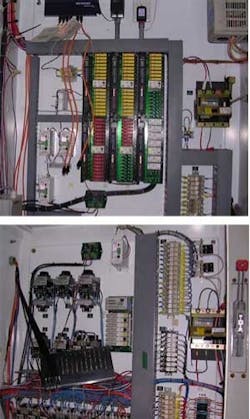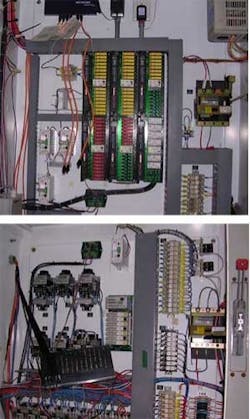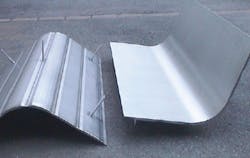Mining Runoff Treatment Gets SCADA Solution
• Upgrade to Opto 22 SNAP PAC System at Colorado’s Leadville Mine Drainage Tunnel proves key to monitoring & controlling water treatment processes
Near the Arkansas River in the heart of the Rocky Mountains lies the city of Leadville, CO. Founded in 1877, it’s most famous for its rich deposits of gold, silver, copper and other valuable metals.
Leadville had its origins as a mining camp for local prospectors and, over the next century, adjacent areas became saturated with metal mines penetrating horizontally and vertically deep into the mountainsides. By the 1980s, huge amounts of water accumulated in abandoned and deteriorating mine shafts – and metals made the water very acidic. This worsened to where the river and other nearby waterways became so contaminated, the water was actually scalding feet and legs of animals that waded into it. After a U.S. Environmental Protection Agency assessment, areas in and around the Leadville Mining District were declared unsafe for human occupation and designated as Superfund sites.
The Leadville Tunnel
The Leadville Mine Drainage Tunnel (LMDT), completed in 1952, was built by the U.S. Bureau of Mines to drain off water from certain areas of the mining district. It runs about 120,000 feet south/southeast to just outside of Leadville. Since 1992, the U.S. Bureau of Reclamation has treated water flowing out of the tunnel – removing dissolved metals and bringing water quality into compliance with regulatory laws and standards, so it can be safely discharged into the Arkansas River.
The I/O panel before and after the upgrade (after is above)
Since 1996, Eugene Csuti has been responsible for automation and electronics for this water treatment plant. Among other things, he implemented and managed a SCADA and process control system for the Bureau of Reclamation to monitor water levels, warn of changing conditions, and remove metals like cadmium, lead, silver and zinc. The SCADA system also adjusts the water’s pH, reduces water turbidity and otherwise treats the water before releasing it cleaner than drinking water.
Csuti began his work by reexamining the installed Opto 22 mistic™ control platform, which included multiple G4LC32 controllers (one of the first programmable controllers developed for the automation industry) and opting to upgrade to the more advanced SNAP PAC System, which features faster and more powerful controllers, straightforward, Windows-based programming, and an easy-to-use HMI development tool. Csuti was able to upgrade to the new hardware, taking advantage of its new features and adding commands without having to alter his still functioning field wiring and I/O.
The new system features Opto 22’s distributed architecture, with standalone controllers communicating to more robust I/Os that monitor and control thousands of points. This I/O is unique as it includes individual processors capable of time critical, processing-intensive, and repetitive tasks, such as high-speed counting, input latching, quadrature counting and, perhaps most significantly, PID loop control.
PID Control
Part of Leadville’s treatment process consists of adding sulfuric acid and other chemicals to the water, which helps contaminants solidify so they can be pumped out as sludge. Using PID loop control regulates this sulfuric acid injection process and helps keep the water’s pH in the acceptable range, typically 7.8 to 8.0. “Our Opto system connects to chemical dosers and PID control speeds up or slows down the injection process to keep the pH correct,” explains Csuti.
Distributed Architecture
Significantly, the PID loop control this process relies on isn’t performed by the programmable automation controller, but instead is executed by the remote processors (also known as “brains”). Offloading the processing-intensive PID loop control to these brains, which are on-the-I/O-rack units situated throughout the facility, effectively pushes control to the I/O level, and this type of distributed architecture offers Csuti many benefits.
He explains: “With our Opto-based distributed SCADA system, the central controller runs the control programs or ‘strategies’ and delegates many functions to the remote brains – from simple I/O reads and writes, to more advanced functions like high-speed counting, pulse generation and measurement, and thermocouple linearization. So by design, this system reduces chances of a system-wide failure, because if the host PAC should malfunction in any way, you still have independent cells operating and performing their own set of tasks without interruption, indefinitely.”
In Csuti’s case, this means that, if his central controller gets knocked offline or out of service for any reason, any SNAP PAC brains distributed across the facility won’t be affected and will continue executing their PID calculations and dosing the water as prescribed.
Another benefit of this distributed architecture relates to wiring, as Csuti’s water treatment operations take place in a massive facility designed with a main control room that communicates to six remote I/O panels plus two remote sites that communicate via fiber optics. These are all wired to I/O that open and close valves, turn devices on and off, and monitor instrumentation. During the daytime shift, Csuti’s SCADA system operates in manual mode and the panels are used for local control. After hours, overnight, and on holidays, the system is switched into automatic mode and the control room takes precedence. Thus, wiring is needed to two distinct locations. Also, for centralized control of the facility’s 2,500+ I/O points, many long wiring runs would need to be establishing and managed. All of this dictated that a distributed architecture would work best.
Parallel Wiring
Csuti has had to wire his entire facility in parallel – literally duplicating the architecture already in place by installing the new hardware and wiring it to the I/O alongside the old hardware. Although this approach has been more time-consuming than a typical hardware removal and replacement would be, the nature of operations at the LMDT, and the considerable impact these operations have on the health and well being of the surrounding populace and environment, have left no other choice.
PACs and I/O racks after the upgrade
“Our facility is a 24/7/365 facility that processes about 2.8 million GPD and our water treatment operations are absolutely critical to this community,” Csuti says. “We’re in a position where we just can’t shut things down for any significant period of time. As a result, we have fewer options in terms of how we can perform our system upgrade. Wiring everything in duplicate has been tricky. We’ve got I/O and components with jury-rigged mounting all over the place.”
Ultimately though, the upgrade will be well worth it, as the new system is a hundred times faster, has better PID handling capabilities, and offers higher-density I/O that will save the Bureau a good deal of space.
With the entire control system configured in parallel, Csuti is able to switch over from his old mistic architecture to his new SNAP PAC architecture, fine tuning it to his exact operating specifications and preferences. As it functions, he evaluates and makes note of adjustments that need to be made. He can then switch back over to the old system and make these adjustments, while still keeping the facility operational. Csuti plans to continue flip-flopping like this until everything is perfect, at which time, he’ll then strip away the old system – controllers, wiring, racks, modules and other hardware – completely.
Fail-safes, Alarms & Reliability
Regulatory bodies continue to monitor the water in and around Leadville. If too much metal is in the water, or it’s otherwise unclean, Reclamation faces major fines. To guard against this, Csuti designed control strategies dictating that if any processes aren’t operating within defined operational guidelines, the SCADA system will issue commands to divert the water output from the river to a secure holding pond until the problem can be corrected and the system reset.
Similarly, when the facility is monitoring in automatic mode, if a valve is detected in a wrong position or any analog readings are out of parameters, the control strategy has the system attempt a restart. If the system cannot restart normally, the entire process shuts down in a safe and orderly fashion. During emergency situations such as this, an autodialer activates and calls one of four individuals (including Csuti), who immediately acknowledges the call and hurries onsite.
The SCADA system also monitors generator sets for power outages – sending instant notifications if any should occur – and uninterruptible power supplies keep the controllers and control strategies running at all times.
“Extensive programming has enabled this system to respond to many different scenarios and conditions,” says Csuti. “The sophistication of our control programs and decision-making that takes place within them makes our system something of a living entity.”
About the Author: David Crump is marketing communications manager for Opto 22, of Temecula, CA. Other articles he wrote were published in Design World, Convenience Store News, Control Engineering, M2M, and Design News. Contact: 800-321-6786, [email protected] or www.opto22.com



